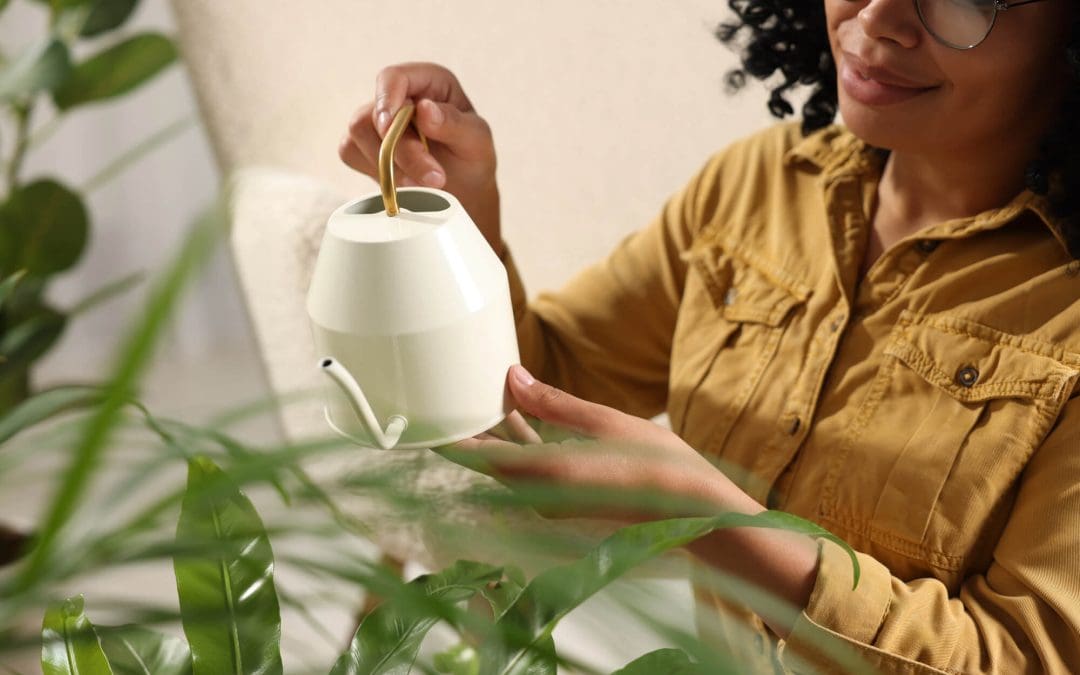Houseplants bring life and personality into a space but are also surprisingly easy to get wrong. If your plants seem to be fading no matter how much attention you give them, you face a common frustration. Most houseplant issues come down to a few simple habits that are easy to correct once you spot them. Let’s break down some of the most common houseplant mistakes people make—and how you can turn things around without a total restart.
Common Houseplant Mistakes: You’re Watering on a Schedule Instead of by Need
Watering every Monday might keep you on track, but your plant doesn’t follow a calendar. Some weeks, it will need more water, and others, it won’t. It all depends on the temperature, light, pot size, and type of plant.
Instead of sticking to a schedule, check the soil. If the top inch is still damp, hold off. If it’s dry, it’s time to water. Plants like consistency, but they don’t want soggy roots. Overwatering is one of the most common reasons houseplants die.
You’re Giving the Wrong Kind of Light
Just because a plant is near a window doesn’t mean it’s getting the right kind of light. Some plants need bright, direct sunlight. Others do better with filtered light or even low light. If your plant’s leaves are turning yellow, becoming leggy, or growing slowly, light might be the problem.
Pay attention to how the sun moves through your space. South-facing windows usually get the most light, while north-facing windows tend to be the darkest. If light is limited, consider rotating your plants or supplementing with a grow light.
You’re Using the Wrong Pot or Soil
That cute pot with no drainage hole? It might be slowly killing your plant. Without proper drainage, water collects at the bottom of the pot and causes root rot. Even if you’re careful with watering, the roots can’t breathe if they’re sitting in stagnant water.
Make sure your pots have drainage holes, and always empty the saucer if water pools underneath. The type of soil matters, too. Standard potting mix works for most houseplants, but succulents and cacti need fast-draining soil. If the soil stays damp for too long, it’s time to repot.
You’re Forgetting to Clean the Leaves
Dust settles on leaves just like it does on your furniture. The problem is, plants breathe through their leaves. When they’re covered in dust, they can’t absorb sunlight or exchange gases as well.
Wipe leaves gently with a damp cloth every couple of weeks. A quick rinse in the shower can do the trick for plants with lots of small leaves.
You’re Moving Plants Around Too Often
Plants get used to their spot. They adapt to the light, humidity, and air flow in that particular place. Moving them around too often can stress them out and cause leaf drop or stalled growth.
Find the right spot based on the plant’s needs and stick with it. If you need to move a plant, do it gradually. Start by placing it in the new spot for a few hours a day, then increase the time over the course of a week.
A few small changes can make a big difference in how your plants look and grow. Pay attention to what your plant is telling you, adjust your care as needed, and you’ll start to see the difference.
FAQs on Common Houseplant Mistakes
How do I know if I’m overwatering or underwatering my plant?
Check the soil and the leaves. Overwatered plants often have yellowing leaves and mushy stems, and the soil will stay wet. Underwatered plants usually have dry, crispy leaves and dry soil that pulls away from the sides of the pot.
Do I need to repot my plant if it’s not growing?
Not always. First, check the roots. If they’re circling the bottom of the pot or coming out of the drainage holes, it might be time to repot. If not, look at the light, water, and temperature before changing the pot.
How often should I fertilize my houseplants?
Most houseplants only need fertilizer during the growing season—usually once a month in spring and summer. Skip it in fall and winter unless the plant is actively putting out new growth.
Can I use tap water on my plants?
Yes, in most cases. But if your tap water is very hard or treated with a lot of chlorine, use filtered water.
Why are the tips of my plant’s leaves turning brown?
That’s often a sign of low humidity, inconsistent watering, or a buildup of minerals in the soil. Try misting the plant, using distilled water, or flushing the soil every few months to remove excess salts.
AAA Professional Home Inspectors offers professional home inspections in Kentucky and Southern Indiana. Contact us to schedule our services.

